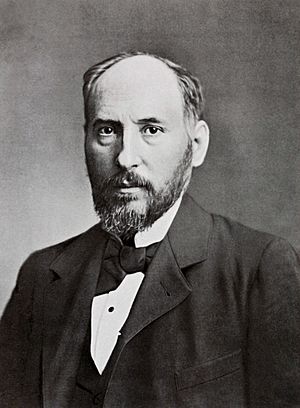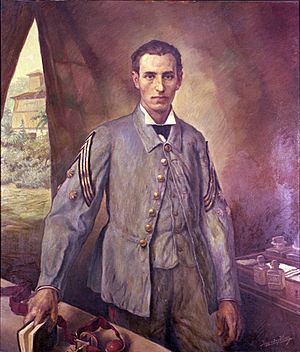Santiago Ramón y Cajal facts for kids
Quick facts for kids
Santiago Ramón y Cajal
|
|
|---|---|

Ramón y Cajal in 1899
|
|
| Born | 1 May 1852 Petilla de Aragón, Spain
|
| Died | 17 October 1934 (aged 82) Madrid, Spain
|
| Nationality | Spanish |
| Education | University of Zaragoza |
| Known for | Fathering modern neuroscience Discovery of the neuron Cajal body, Cajal–Retzius cell, Interstitial cell of Cajal, Neuron doctrine, Growth cone, Dendritic spine, Long-term potentiation, Mossy fiber, Neurotrophic theory, Axo-axonic synapse, Pioneer axon, Pyramidal cell, Radial glial cell, Retinal ganglion cell, Trisynaptic circuit, Visual map theory |
| Awards | Nobel Prize in Physiology or Medicine (1906) |
| Scientific career | |
| Fields | Neuroscience Pathology Histology |
| Institutions | University of Valencia Complutense University of Madrid University of Barcelona |
| Signature | |
Santiago Ramón y Cajal (born May 1, 1852 – died October 17, 1934) was a Spanish scientist. He studied the brain and nervous system. He was a neuroscientist, a pathologist (someone who studies diseases), and a histologist (someone who studies tissues).
In 1906, he won the Nobel Prize in Physiology or Medicine with Camillo Golgi. Ramón y Cajal was the first person from Spain to win a science Nobel Prize. His work on the tiny parts of the brain made him a leader in modern neuroscience.
Many of his drawings of brain cells, which look like tiny trees, are still used today. They help students learn about the brain.
Contents
Biography of a Brain Explorer
Santiago Ramón y Cajal was born on May 1, 1852, in Petilla de Aragón, Spain. As a child, he moved between many schools. This was because he was often rebellious and didn't like being told what to do. Once, when he was eleven, he even got into trouble for destroying a neighbor's gate with a homemade cannon!
Santiago loved to paint, draw, and do gymnastics. His father didn't really support these hobbies. But these artistic skills later helped him greatly in his science work. His father even tried to make him a shoemaker and a barber. He hoped this would teach Santiago discipline.

In 1868, his father took him to graveyards. There, they found human bones for Santiago to study. Drawing these bones made him want to study medicine. He went to the medical school at the University of Zaragoza. His father taught anatomy there.
Santiago graduated in 1873 when he was 21. Then, he joined the Spanish Army as a medical officer. He went to Cuba in 1874–1875. While there, he got sick with malaria and tuberculosis. To get better, he spent time in a spa town in the Pyrenees mountains.
After returning to Spain, he earned his doctorate in medicine in Madrid in 1877. Two years later, he became the director of the Zaragoza Museum. He married Silveria Fañanás García. They had seven daughters and five sons.
Ramón y Cajal worked at the University of Zaragoza until 1883. Then, he became an anatomy professor at the University of Valencia. Early in his career, he studied how the body reacts to injury and disease. He also looked at tiny living things that cause cholera.
In 1887, Ramón y Cajal moved to Barcelona to teach. There, he learned about Golgi's method. This was a special way to stain cells. It used chemicals to make some brain cells turn dark black. The cells around them stayed clear. This method was very important for his work. It helped him study the central nervous system (the brain and spinal cord). Without it, the cells were too tangled to see clearly. During this time, he made many detailed drawings of nerve cells from different animals and brain areas.
In 1892, he became a professor in Madrid. He later became the director of the National Institute of Hygiene in 1899. In 1922, he started the Laboratory of Biological Investigations. This lab was later renamed the Cajal Institute.
Santiago Ramón y Cajal died in Madrid on October 17, 1934. He was 82 years old. He kept working on his research even when he was very ill.
Santiago's Ideas and Discoveries
Ramón y Cajal made huge discoveries about the brain's structure. He found the growth cone, which is like a tiny growing tip on nerve cells. He also showed that nerve cells are not directly connected. Instead, there are tiny gaps between them. This was a big deal! Before him, many scientists thought nerve cells were all part of one big network.
His discovery proved the "neuron theory." This theory says that the brain is made of many separate cells called neurons. This idea is now the base of modern neuroscience. Some people even call him the first "neuroscientist." In 1894, he said that neurons can grow and make new connections. This helps us learn new things. This idea is thought to be the start of the "synaptic theory of memory."
He also believed in dendritic spines. These are tiny bumps on nerve cells. He thought they were important, even though he didn't know they were where signals were received. His student, Rafael Lorente de Nó, continued his work. He studied how signals travel through nerve cells.
Ramón y Cajal also found a new type of cell. It was named after him: the interstitial cell of Cajal (ICC). These cells are found in the muscles of the gut. They act like pacemakers, creating slow waves that help move food through your digestive system. They also help nerve signals reach the gut muscles.
In 1894, he compared brain cells called pyramidal cells to trees. He suggested that these cells might grow more complex over time, just like a tree grows its branches.
Awards and Honors
Ramón y Cajal received many awards and honors during his life. He got special degrees from universities like Cambridge and Würzburg.
His most famous award was the Nobel Prize in Physiology or Medicine in 1906. He shared it with Italian scientist Camillo Golgi. They won for their work on the nervous system. This caused some debate because Golgi believed nerve cells were connected in a network. Ramón y Cajal, however, proved they were separate. Also, another scientist, Fridtjof Nansen, had shown nerve cells were separate before Cajal. But Ramón y Cajal didn't mention Nansen's work.
Santiago Ramón y Cajal in Culture
Many things have been created to honor Santiago Ramón y Cajal:
- In 1906, a famous painter named Joaquín Sorolla painted his official portrait.
- A statue of him was made in 1924 at the University of Zaragoza.
- In 1931, a large statue of him was put up in Madrid, Spain.
- A TV mini-series about his life was made in Spain in 1982.
- In 2003, a big exhibition of his scientific drawings opened in Madrid. It showed hundreds of his original drawings and photos.
- In 2005, an asteroid was named 117413 Ramonycajal after him.
- The Santiago Ramón y Cajal Museum opened in 2013 in his childhood home in Ayerbe, Spain.
- The National Institutes of Health in the US started an exhibition of his drawings in 2014.
- His drawings were also shown at the Istanbul Biennial in Turkey in 2015.
- In 2017, an exhibition called The Beautiful Brain: The Drawings of Santiago Ramón y Cajal traveled across North America.
- In 2019, Spanish TV channel RTVE showed a series about his life.
- In 2020, volunteers from six countries created 81 hand-stitched pictures of his drawings.
- In 2017, UNESCO (a part of the United Nations) said that Cajal's collection of work is a World Heritage treasure. People are now asking for a special museum to show his work and the work of his students.
- Every year, Spain gives out "Ayudas a contratos Ramon y Cajal" fellowships. These help scientists continue their research, honoring his memory.
Gallery of Amazing Drawings
-
Drawing of the neural circuitry of the rodent hippocampus.
-
Drawing of the cells of the chick cerebellum.
-
Drawing of a section through the optic tectum of a sparrow.
-
From "Structure of the Mammalian Retina" Madrid, 1900
See also
 In Spanish: Santiago Ramón y Cajal para niños
In Spanish: Santiago Ramón y Cajal para niños
- List of pathologists













